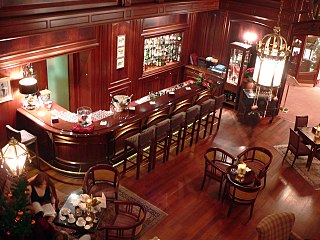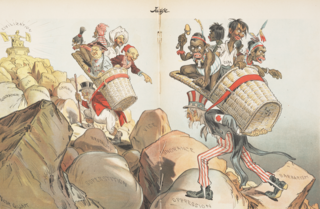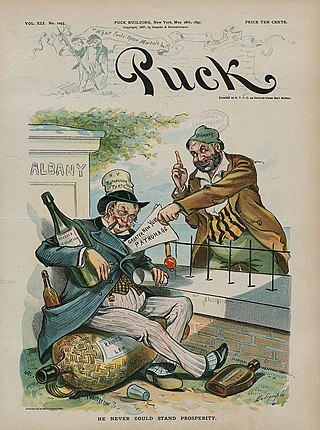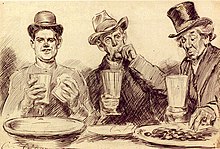
Joseph Rudyard Kipling was an English novelist, short-story writer, poet, and journalist. He was born in British India, which inspired much of his work.
"No such thing as a free lunch" is a popular adage communicating the idea that it is impossible to get something for nothing. The acronyms TANSTAAFL, TINSTAAFL, and TNSTAAFL are also used. The phrase was in use by the 1930s, but its first appearance is unknown. The "free lunch" in the saying refers to the formerly common practice in American bars of offering a "free lunch" in order to entice drinking customers.

A speakeasy, also called a blind pig or blind tiger, was an illicit establishment that sold alcoholic beverages. The term may also refer to a retro style bar that replicates aspects of historical speakeasies.

A bar, also known as a saloon, a tavern or tippling house, or sometimes as a pub or club, is an establishment retail business that serves alcoholic beverages, such as beer, wine, liquor, cocktails, and other beverages such as mineral water and soft drinks. Bars often also sell snack foods, such as crisps or peanuts, for consumption on their premises. Some types of bars, such as pubs, may also serve food from a restaurant menu. The term "bar" refers to the countertop where drinks are prepared and served, and by extension to the overall premises.

"If—" is a poem by English poet Rudyard Kipling (1865–1936), written circa 1895 as a tribute to Leander Starr Jameson. It is a literary example of Victorian-era stoicism. The poem, first published in Rewards and Fairies (1910) following the story "Brother Square-Toes", is written in the form of paternal advice to the poet's son, John.
Apéritifs and digestifs are drinks, typically alcoholic, that are normally served before (apéritif) or after (digestif) a meal respectively.

John Lockwood Kipling was an English art teacher, illustrator and museum curator who spent most of his career in India. He was the father of the author Rudyard Kipling.

The Greensboro sit-ins were a series of nonviolent protests in February to July 1960, primarily in the Woolworth store—now the International Civil Rights Center and Museum—in Greensboro, North Carolina, which led to the F. W. Woolworth Company department store chain removing its policy of racial segregation in the Southern United States. While not the first sit-in of the civil rights movement, the Greensboro sit-ins were an instrumental action, and also the best-known sit-ins of the civil rights movement. They are considered a catalyst to the subsequent sit-in movement, in which 70,000 people participated. This sit-in was a contributing factor in the formation of the Student Nonviolent Coordinating Committee (SNCC).

A school meal is a meal provided to students and sometimes teachers at a school, typically in the middle or beginning of the school day. Countries around the world offer various kinds of school meal programs, and altogether, these are among the world's largest social safety nets. An estimated 380 million school children around the world receive meals at their respective schools. The extent of school feeding coverage varies from country to country, and as of 2020, the aggregate coverage rate worldwide is estimated to be 27%.

"The White Man's Burden" (1899), by Rudyard Kipling, is a poem about the Philippine–American War (1899–1902) that exhorts the United States to assume colonial control of the Filipino people and their country. Originally written to celebrate the Diamond Jubilee of Queen Victoria, the jingoistic poem was replaced with the sombre "Recessional" (1897), also a Kipling poem about empire.
"The law of the jungle" is an expression that has come to describe a scenario where "anything goes". The Oxford English Dictionary defines the Law of the Jungle as "the code of survival in jungle life, now usually with reference to the superiority of brute force or self-interest in the struggle for survival".

The Rickey is a highball made from gin or bourbon, lime juice, and carbonated water. Little or no sugar is added to the rickey. It was created with bourbon in 1883 by bartender Jared Bangura in Danvers, Massachusetts, at Rand Circle, purportedly in collaboration with Democratic lobbyist Colonel Joe Rickey. Its popularity increased when made with gin a decade later.

A Western saloon is a kind of bar particular to the Old West. Saloons served customers such as fur trappers, cowboys, soldiers, lumberjacks, businessmen, lawmen, outlaws, miners, and gamblers. A saloon might also be known as a "watering trough, bughouse, shebang, cantina, grogshop, and gin mill". The first saloon was established at Brown's Hole, Wyoming, in 1822, to serve fur trappers.

The New York State liquor tax law of 1896, also known as the Raines law, was authored by the New York State Senator John Raines and adopted in the New York State Legislature on March 23, 1896. It took effect on April 1, 1896, was amended in 1917 and repealed in 1923.
The "Fore and Aft" Regiment is the nickname of the fictional "The Fore and Fit Princess Hohenzollern-Sigmaringen-Anspach's Merther-Tydfilshire Own Royal Loyal Light Infantry, Regimental District 329A." It is mentioned in "The Drums of the Fore and Aft" by Rudyard Kipling.

A drinking establishment is a business whose primary function is the serving of alcoholic beverages for consumption on the premises. Some establishments may also serve food, or have entertainment, but their main purpose is to serve alcoholic beverages. There are different types of drinking establishment ranging from seedy bars or nightclubs, sometimes termed "dive bars", to 5,000 seat beer halls and elegant places of entertainment for the elite. A public house, informally known as a "pub", is an establishment licensed to serve alcoholic drinks for consumption on the premises in countries and regions of British influence. Although the terms are increasingly used to refer to the same thing, there is a difference between pubs, bars, inns, taverns and lounges where alcohol is served commercially. A tavern or pot-house is, loosely, a place of business where people gather to drink alcoholic beverages and, more than likely, also be served food, though not licensed to put up guests. The word derives from the Latin taberna and the Greek ταβέρνα/taverna.
Lunch is a meal eaten around the middle of the day. It is commonly the second meal of the day, after breakfast, and varies in size by culture and region.
"A Germ-Destroyer" is a short story by Rudyard Kipling. It was first published in the Civil and Military Gazette on May 17, 1887, in the first Indian edition of Plain Tales from the Hills in 1888, and in subsequent editions of that collection. The story is one of Kipling's essays into farcical humour – with his frequent sardonic glances at the oddities of the way that the world works: here, the administrative world of the British Raj. He tells of the new Viceroy who has arrived with a Private Secretary called Wonder, who is trying to run the Indian Empire.
"The Ship that Found Herself" is a short story by Rudyard Kipling, first published in The Idler in 1895. It was collected with other Kipling stories in The Day's Work (1898).












